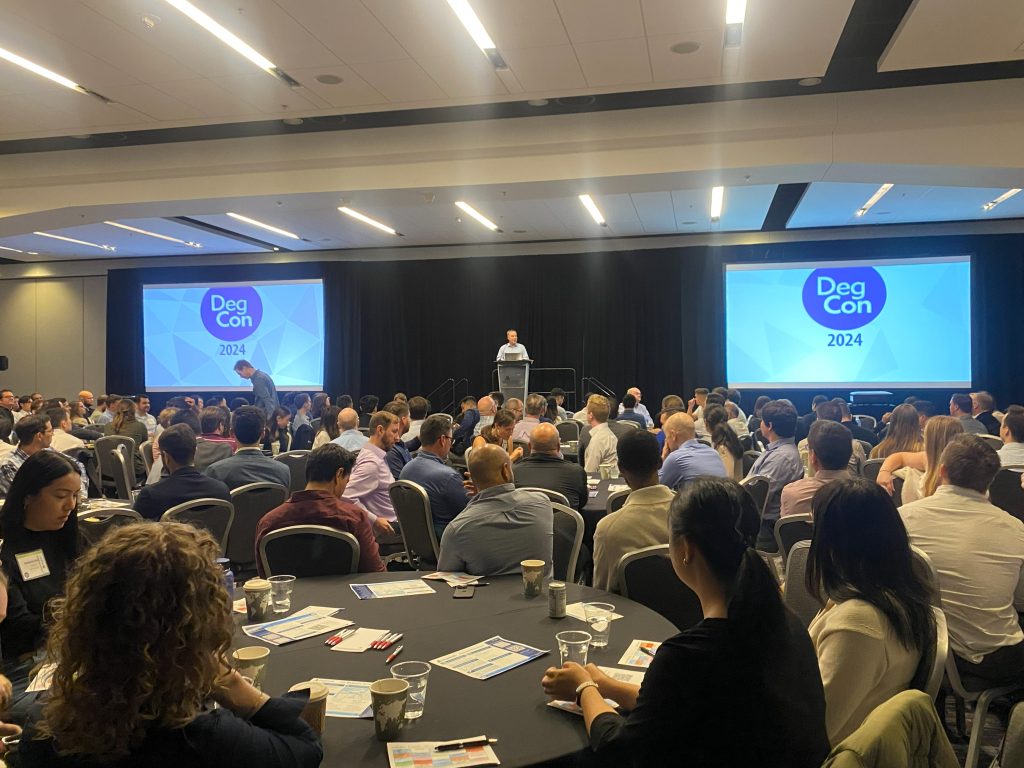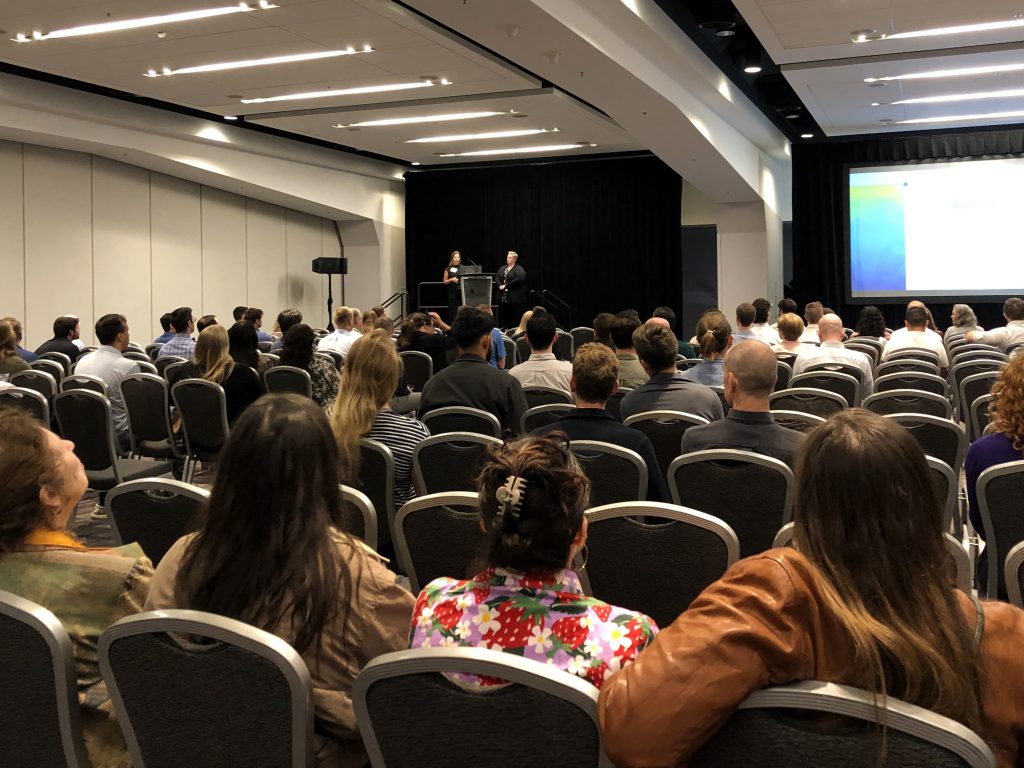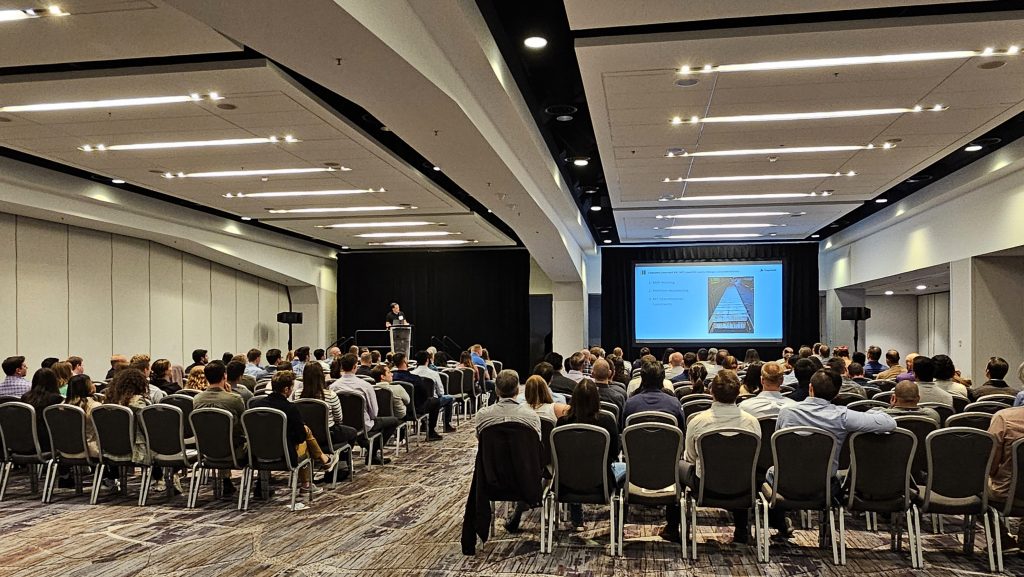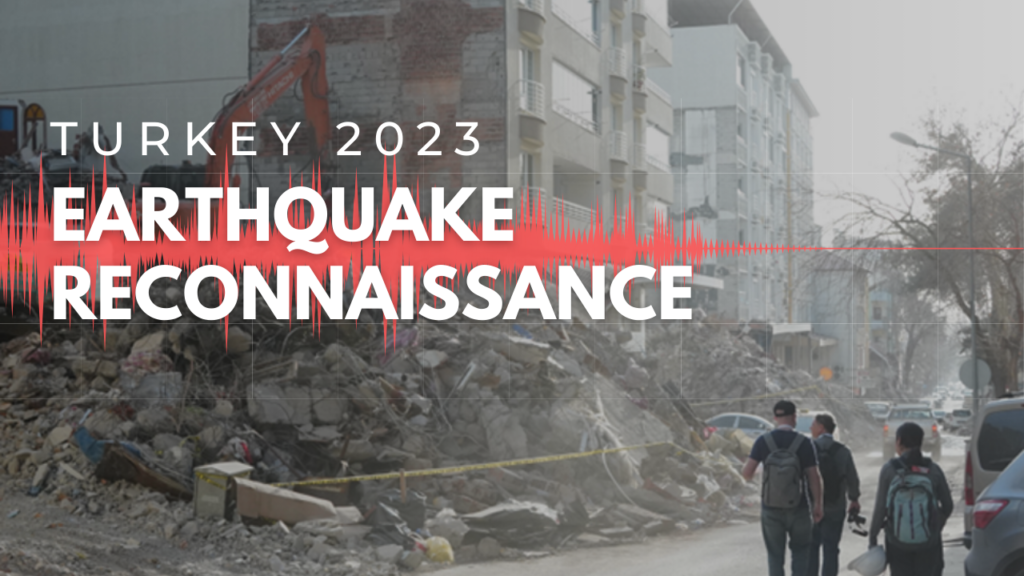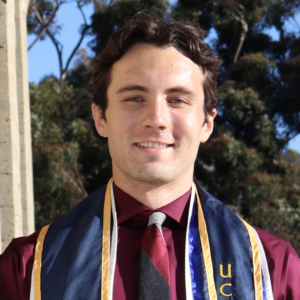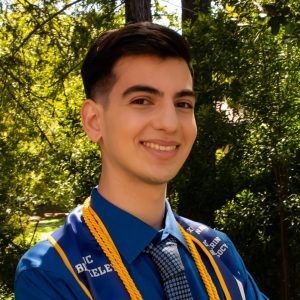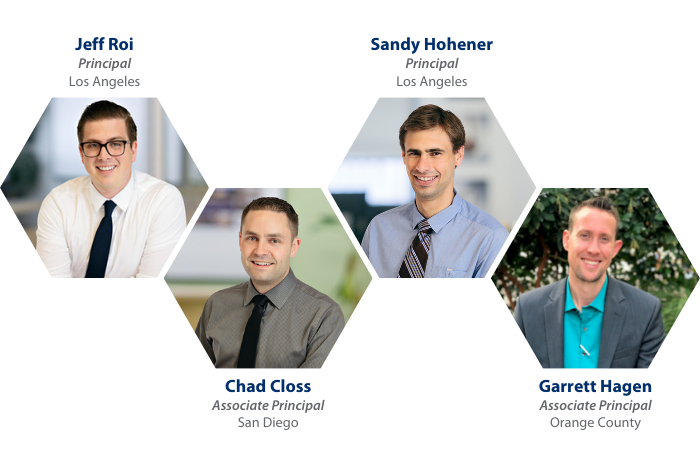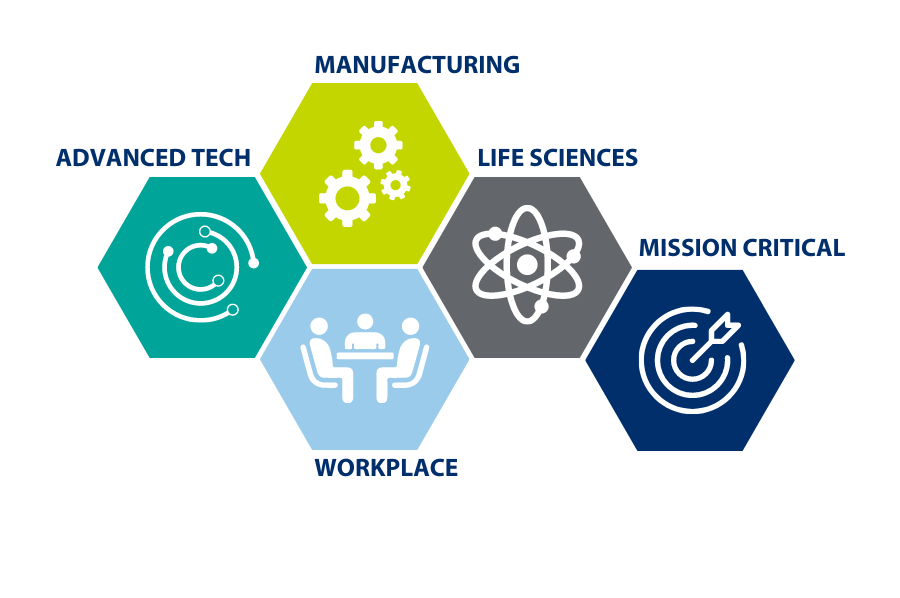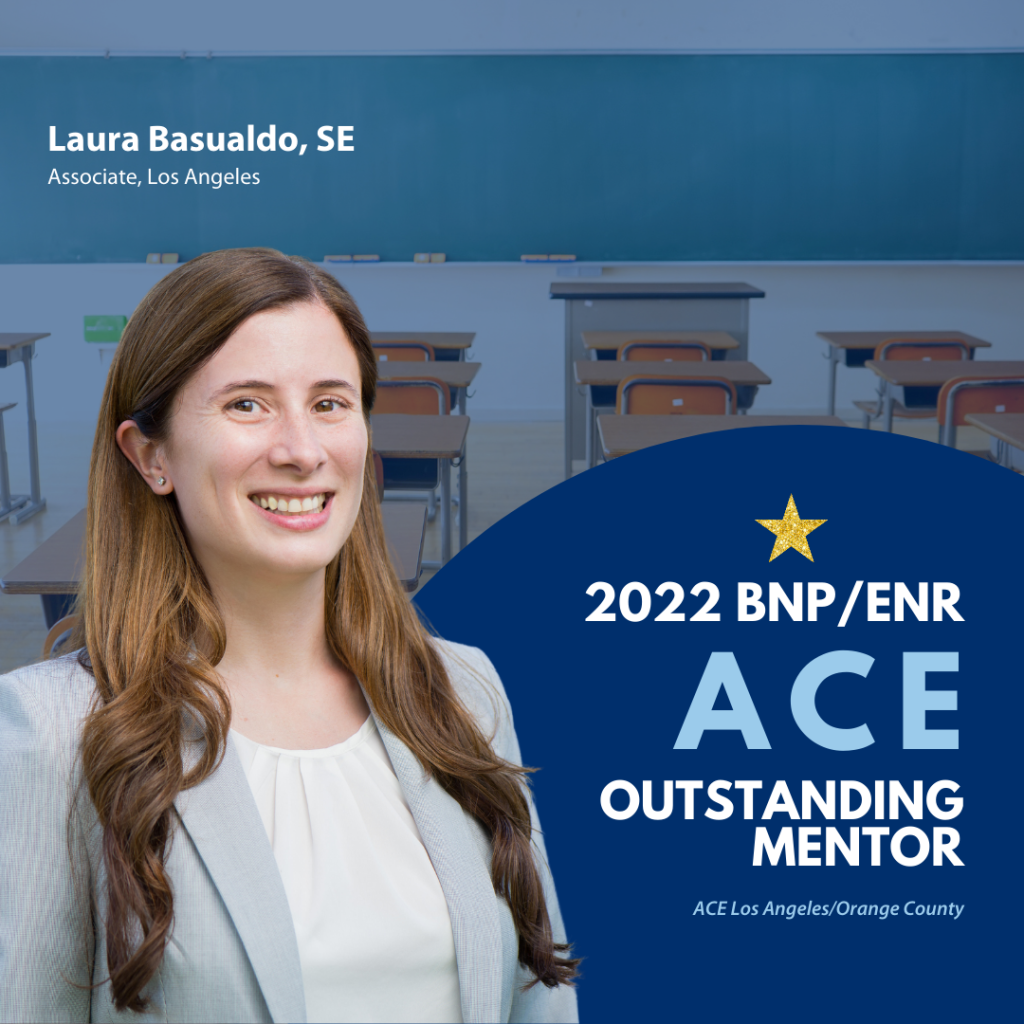Matt Barnard Named Healthcare Practice Area Leader
We are excited to announce Matt Barnard as our new Healthcare Practice Area Leader! In this role, Matt will be leading our talented firm-wide team, providing services to our healthcare providers and design and construction partners.
Matt’s new role builds upon the momentum created by last year’s appointments of Jorn Halle as our Chief Client Officer and Michael Braund as our Chief Operations Officer. These strategic leadership changes strengthen our ability to drive growth, enhance our client partnerships, and shape the future of structural engineering in all the markets we serve.
Congratulations to Matt as he takes on this new role!
DegCon 2024 In Review
Another amazing year in the books at the 2024 Degenkolb Conference! 💡 DegCon brought 300-plus Degenkolb and Ruby + Associates, a Degenkolb Company team members together in San Francisco for a day dedicated to learning, collaboration, and celebrating our people. This annual event highlights our commitment to lifelong learning, giving team members the chance to present on topics they’re passionate about. Check out the full list of presentations from this year’s event!
Topics at the 2024 Degenkolb Conference:
- KEYNOTE: Innovation – Our Earlier Years with Loring A. Wyllie, Jr.
- SESSION IA:
- Help Me Name This Too! – Daniel Zepeda and Robert Wang
- My learnings from the pursuit and the design of seismically isolated projects – Atila Zekioglu
- From the Owner’s Table: Making a connection with the first impression – Matt Barnard and Laurie Lumish
- SESSION IIA:
- Project Team Supplantation: Rescue Me! – Chris Hilson and Devon Lumbard
- Seeing Through the Debris: Structural Engineers in Urban Search and Rescue – Jack Wegleitner and Jerry Luong
- SESSION IIIA:
- Networking 101: Build Your Network at Every Stage of Your Career – Kenda Salisbury and Megan Schroeder
- Heavy Lift Engineering featuring Syracuse Carrier Dome – Chad Fox and Evan Fredline
- Tulsa Pedestrian Bridge Erection: Thermal Expansion & Constructability Considerations – Bruce Burt and Tim Francisco
- SESSION IB:
- You Won’t Believe How Tall This Wall Is – Enrico Alvaro, Robert Graff, Tim Nelson
- From a Whisper to a Win: How We Learn About, Position For, and Win Work! – Rebecca Weldon and Kenda Salisbury
- SESSION IIB:
- NPC Go Forward Showcase; Innovating to Solve the Real NPC 4 Need – Laura Rice and Rory Lopez-Esce
- Drama in the Office, theatre renovation – Octavio Cortes and Candice Hanna
- Using Genetic Algorithms to Solve Design Problems – Daniel Gaspar
- Elevating Equipment Anchorage – Jerry Luong and Christopher Neumann
- SESSION IIIB:
- Hear All the Voices – How to Have an Inclusive Meeting – Jen Gross
- Reduce, Reuse, Retrofit, Replace: Are building retrofits always more sustainable than new builds? – Elena Good and Jason Scanlan
- SESSION IC:
- LeanSteel – Erik Ohlsson and Michael Chisholm
- Making Connections: Degenkolb Seattle’s First Collaboration with Ruby + Associates – Addie Albro, Chris Neisius, Clare Cummins
- How to Create S.M.A.R.T. Goals for Your Career Development – Jennie Kenhard and Mary Beth Del Vero
- SESSION IIC:
- Challenges, new tools, and lessons learned in a New Building Design – Christian Hall, Luis Pancardo, Michael Leung
- Pipe Wars: The Graph Awakens – Framework for Point load Derivation of MEP Systems using PyRevit + Graph Search – Yang Xie, Angshuman Deb, Hamid Koodiani, Wesley Chen
- Inventing Solutions: Developing a TADAS-Style Seismic Fuse for Non-Ductile Steel Braces – Felipe Bedecarratz and Garrett Hagen
- Simpson Yield-Link Braced Frame – Degenkolb’s First Use – Clare Cummins
- SESSION IIIC:
- Moment of Inertia: Overcoming Resistance to Productive Habits – David Sommer
- Functional Recovery… Can We Actually Predict It? – Bob Pekelnicky, Paige Kohrs-Herwig, Hannah Thompson
- Concrete Issues in Construction & More – Alex Motzny and Austin Shakiban
See you next year at DegCon 2025!
Internationally recognized structural engineer, Atila Zekioglu, joins Degenkolb Engineers and starts Design Practice Area
Degenkolb Engineers is thrilled to welcome Atila Zekioglu to the firm. Atila joins us in our Los Angeles office as a Senior Principal and Design Practice Area Leader. Throughout his 40-year career, Atila has been at the forefront of advancing structural engineering and providing cutting-edge engineering solutions for technically challenging projects worldwide.
“At Degenkolb, I am now part of a team of structural engineering partners dedicated to delivering excellence in structural engineering for the betterment of our clients and community. Degenkolb continues its legacy of outstanding work, and I am joining this group to contribute the same level of excellence and beyond, building upon the successful track record I have established in my career.”
Atila’s interest in earthquakes was sparked by his father’s accounts of the aftermath of the 1953 Paphos, Cyprus earthquake. With a passion for math and physics as well as problem-solving, he pursued structural engineering, earning his master’s degree from the University of California, Berkeley.
A leader in the field, Atila pushes the bounds of structural engineering. Following the 1994 Northridge earthquake, he pioneered reduced-beam-section steel moment connections, successfully tested at UC San Diego as the first of their kind in the U.S.
His portfolio includes the Sakura City Hospital in Istanbul, recognized as the world’s largest seismically isolated contiguous structure, as well as award-winning structures around the world, including the Guggenheim Abu Dhabi, The Samuel Oschin Air and Space Center, and the Allegiant Stadium in Las Vegas. Additionally, Atila is a council member of the Los Angeles Tall Buildings and Structural Design Council and leads the Council’s Resiliency Committee.
Launching the Design Practice Area at Degenkolb, Atila employs cutting-edge digital technology to engage in the creative design exploration process.
“When others say it can’t be done, I’m the guy who generates ideas about how it can be done in different ways.”
This design exploration, or digital transformation, reflects his belief that the A/E/C space is abundant with ideas and their value is maximized when timely.
His passion for digital transformation stems from an ambition to minimize the time lag between ideation, testing, and presenting to stakeholders for well-informed decisions. A firm believer in the necessity of rigorous study and comparison of multiple concepts for good structural design, he incorporates strategies like automation and digital workflows, adapting to the ever-evolving landscape of technologies. Atila is also passionate about collaboration, which he views as a continuum rather than a one-time transaction.
In the design environment, his focus extends beyond the Degenkolb team, ensuring the value of everyone’s input. Recognizing design as a social interaction, he actively seeks to facilitate, contribute to, and nurture its growth, believing that this not only enhances the experience but also the outcome.
Degenkolb Engineers is excited to welcome Atila to our firm, where he brings his extensive experience in structural and seismic expertise. With his ability to inspire and lead, we are confident in his contribution to the ongoing elevation of Degenkolb and our firm’s purpose: engineering a better future for our clients, communities, and employees.
That’s a Wrap on DegCon 2023! 💡
That’s a wrap on the 2023 Degenkolb Conference! 💡🏗️🎉 Degenkolb’s annual company conference—also known as DegCon—brought together 200-plus Degenkolbers from every office to San Francisco for a day of knowledge sharing, collaboration, and a celebration of what the firm is all about: its people. This event is part of the company commitment to life-long learning, offering the opportunity for Degenkolbers to present educational topics of their choosing. Continue reading for a list of all the topics presented at this year’s Degenkolb Conference.
Topics at the 2023 Degenkolb Conference:
- KEYNOTE: Wellbeing at Work: The New Organizational Competitive Edge with María G. Hernández, PhD
- SESSION IA:
- What’s the collapse probability of my building? – Daniel Gaspar
- Don’t let Torsional Irregularity twist you into knots: Lessons from HUCLA Project Plan Check – Anuj Bansal, Robert Pekelnicky, Dhawal Desai
- UCDH California Tower: Quantifying the Cost of Irregularities – Elena Good and Robert Wang
- SESSION IB:
- Brace Yourself: The design story of the UCI Medical Center – Irvine – Daniel Lin and Eden Wong
- Carving out a Chunk of Mt. Sutro: The Soil Nail Wall at UCSF NHPH – Amy Inhofer, Claire Killian, Alan Roberts
- Using Shotcrete on an HCAI New Building…Who does that? – Carmen O’Rourley, Daniel Zepeda
- SESSION IC:
- You too can have a virtual twin! Introducing our new Navis VLX Scanners – Sal Hernandez, Tracey Cornell, Laura Rice
- Tools + Technology in Forensics Data Collection – Fabian Cortes and Bianca Casem
- Specialty Systems Engineering: Experience Working for an Elevator Manufacture – Hagen Tam and Erik Moore
- Elevation Sickness – an Insight into Elevator Modernization Projects and Lessons Learned – Andrew McHale
- SESSION IIA:
- The Degenkolb Brand: What is it? How does it work for you? – Laurie Lumish
- Effective Impromptu Public Speaking Tips & Tricks – Bianca Casem and Chris Neisius
- Don’t talk about my engineer like that! – Megan Schroeder and Chad Closs
- Therapy Needed: A project management story – Matt Barnard and Ariel Creagh
- SESSION IIB:
- Extra! Extra! Read All About It! Big Changes at the Degenkolb Library! – Lindsay Forgione
- Oh, Snow! Forensics Project Considerations, Approach, and Looking into the Future – Jared Ouellette, Catherine Moore, Jordan Rutledge
- Cold-Formed Steel Building: Not Too Simple – Charlie Chi
- SPC-4D: What Wood You Do? Alternative approaches to Light-Framed Building Evaluations – Jaelen Pearson, Chris Hilson, Devon Lumbard
- SESSION IIC:
- We, we, we…all the way home! Why Proposal Cover Letters Aren’t About You – Kenda Salisbury
- REVIT… don’t be scared of it! – Luis Pancardo and Hector Martinez
- Oh Snap! Lessons from a PT Tendon Failure Investigation – Torrey Bolden
- What’s the Point? Communicating Our Goals for Point Load Submittals – Christian Curameng
- SESSION IIIA:
- Really? No Way. The construction story of the UCI Medical Center – Irvine – Matt Barnard
- Who Doesn’t Love a CA Lessons Learned Presentation? – Curtis Siegfried, Alex Barnes, Brendin Randall, Robert Wang, Wayne Low
- Not-so-smooth Sailing: Lessons from Friction Damper Design and Testing for a Healthcare Retrofit Project –Justin Tan and Christopher Neumann
- SESSION IIIB:
- P58 Analysis at Degenkolb – An additional dimension for performance-based engineering – Hannah Thompson
- Taming the Wild ASCE 41-23 Shear Wall Provisions: Crestmont and Harrison Tower Voluntary Retrofit – Ariane Rosario and Fendy Setiawan
- FEMA P-2055-2: Recommendations for Cordoning Earthquake-Damaged Buildings – Amy Inhofer and Jack Wegleitner
- SESSION IIIC:
- The Business of Structural Software Development: Lesson Learned from Pushing the Edges – Peter Fobel and Andrew Scott
- The Catacombs: Spelunking through Tight Spaces and Concrete Assessment and Repair at the Bay Scene – Valentina Couse-Baker
- Dynamic characteristics of buildings in the vertical component of motion – Andres Acosta
See you next year at DegCon 2024!
Get to Know Degenkolb’s Summer 2023 Interns
As temperatures rise, so do the number of seats occupied in the Degenkolb offices thanks to the influx of summer structural engineering interns! These 10 up-and-comers bring a mix of classroom wisdom and a serious passion for all things structural. From Seattle to San Diego, get to know more about these new faces and their unique experiences as summer 2023 interns.
What school are you attending?
I did my undergraduate degree at UC Berkeley and am now in my second year at Stanford pursuing my master’s.
How did you find out about Degenkolb?
I found out about Degenkolb from word of mouth from people at Stanford.
What have you been working on this summer?
This summer I did ATC work where I designed a concrete moment frame building according to the 1994 UBC. The goal of this project is to then evaluate this design to current standards to inform us how older buildings should be retrofitted. I also worked on building Revit tools using the Py Revit API as well as some forensic work.
What memory stands out to you from your internship?
The most impactful memory from my time here was completing my ATC project which took me eight weeks to complete.
If you could give future interns any advice on how to get the most out of their internship, what would it be?
I would recommend being vocal about your goals and seeking and meeting the people that are doing the work which you want to do in the future.
Describe your ideal day off.
My ideal day off starts with getting up relatively early say 9am. I would then head to the gym and get a good workout and shower in there, before heading to a lovely breakfast spot and enjoy a quality meal with a nice coffee. I would then take a book to a park with some friends and either just hangout; play some games; or read. Following this would be dinner with friends followed by a fun night out.
What school are you attending?
I attended UC Davis for undergrad and I’m currently a graduate student at Stanford University. I’m heading into my second year in the fall and plan to complete my master’s degree by the spring!
How did you find out about Degenkolb?
One of my classmates at Stanford was an intern last year and he spoke well of his experience. I also had a chance to meet a few engineers from Degenkolb at my school’s career fair last fall.
What have you been working on this summer?
I designed equipment anchorage for a confidential client in the science & tech industry. I’m working on a research project that involves designing a concrete moment frame building according to different codes to see how codes have changed over time. I’ve also had the chance to develop tools for Revit using Python.
What memory stands out to you from your internship?
The difference between school and the industry has been eye-opening. I get to apply what I’ve learned from school on a real project while also gaining more practical skills that I could only get in the industry. Overall, I feel like my conceptual knowledge has been solidified through my time at Degenkolb.
If you could give future interns any advice on how to get the most out of their internship, what would it be?
If you have a specific interest that you want to explore, reach out to the people involved! For example, I’m interested in programming, so I let my manager know and I was invited to work on a programming project. Also, the social events are a great way to get to know your coworkers and make connections.
Describe your ideal day off.
My ideal day off starts with getting up relatively early say 9am. I would then head to the gym and get a good workout and shower in there, before heading to a lovely breakfast spot and enjoy a quality meal with a nice coffee. I would then take a book to a park with some friends and either just hangout; play some games; or read. Following this would be dinner with friends followed by a fun night out.
What school are you attending?
My undergrad was at Oregon State. Go Beavs! I’m currently in my 2nd year for my master’s at Stanford.
How did you find out about Degenkolb?
At the Stanford Career Fair.
What have you been working on this summer?
I’ve worked on the UCSF PRAB project.
What memory stands out to you from your internship?
Going to the Taylor Swift concert with colleague, Andres Acosta!
If you could give future interns any advice on how to get the most out of their internship, what would it be?
Try hard, and never miss a Forkable lunch order.
Describe your ideal day off.
Good food and exploring a new place with someone I love.
What school are you attending?
I attended UC Davis for my undergraduate degree (just graduated!) and I’ll be attending Cal Poly for my master’s degree after my internship ends.
How did you find out about Degenkolb?
I found out about Degenkolb through my Steel Design professor at UC Davis who was asked by a Degenkolb engineer to share information about a summer internship opportunity with his students. It just so happened that this Degenkolb engineer was a former UC Davis PhD student (now graduated) who taught my Structural Analysis class!
What have you been working on this summer?
This summer, I’ve been able to see a wide range of projects. I started off the summer visiting reconstruction sites and designing temporary construction shoring for one RCN project. Then, I was able to get into the structural modeling side of things, using software like RAM, ETABS, and EnerCalc—none of which I had seen before—for projects ranging from early-stage planning for a community center, to vibration analysis for mass-timber structures, to footing design for a hospital building.
What memory stands out to you from your internship?
Beyond learning a lot about structural engineering practice itself, I think some of the most meaningful memories I’ve made while at Degenkolb are from my interactions with the rest of the office. Chatting (or just listening) to the staff around the office or at lunch and joining social outings with them after work, like painting pottery with the Women’s Group, helped me get to know everyone a little better and feel like a part of the team in Oakland.
If you could give future interns any advice on how to get the most out of their internship, what would it be?
Though this will probably make me sound like a broken record, asking questions is the most important thing you can do to make your time at Degenkolb valuable to yourself and those you work with. Asking questions may not come naturally to everyone (it certainly doesn’t with me), but I’ve always felt encouraged to ask questions and ask them sooner rather than later. If you’re just finishing your undergraduate degree, you might be feeling entirely out of your depth. That’s something that people at Degenkolb understand, and everyone I’ve worked with has been so helpful at explaining concepts or projects to me that I hadn’t seen before or guiding me toward resources to learn about them on my own.
Describe your ideal day off.
My ideal day off would probably consist of attending another Taylor Swift concert with friends, but while that’s not possible, I enjoy playing The Legend of Zelda and spending time with my cat Louie at home!
What school are you attending?
I graduated Cal Poly, San Luis Obispo this past spring quarter with a degree in Civil Engineering and will be attending UC San Diego to pursue my Masters in Structural Engineering in the fall.
How did you find out about Degenkolb?
Degenkolb did a presentation about mass timber structures in one of my undergrad design classes. Afterwards, I was very interested in getting involved with the company’s diverse and complex projects.
What have you been working on this summer?
I’ve worked on a structural non-performance component study for a local hospital, performed equipment anchorage calculations for a new hospital construction, and I’ve also created an ETABS seismic evaluation model of a six-story reinforced masonry hotel structure.
What memory stands out to you from your internship?
I had the opportunity to conduct one of Degenkolb’s first hospital survey walks using a new lidar scanner that maps out equipment noncompliance areas of the building. While I did have the great privilege of waking up at 4am to do this survey, I also got to interact with many of the patrons and essential workers onsite who were curious as to what our team was doing. I took pride in knowing that the work I do contributes to ensuring the safety of every patient and hospital worker affiliated with that hospital.
If you could give future interns any advice on how to get the most out of their internship, what would it be?
I would recommend that every Degenkolb intern be prepared to ask a lot of questions. Ask any question that pops into your head, be it big or small, because chances are your co-workers will give you an answer and then some! Everyone in the office, from designer to principal, is very approachable and will go out of their way to help you out with any questions you have! The feedback I received helped me learn more about structural engineering than I could have on my own, so definitely stay curious and ask questions throughout your internship!
Describe your ideal day off.
My ideal day off would start with a morning hike on one of San Diego’s many open space trails, followed by some authentic fish tacos for lunch, then a necessary afternoon nap, and an evening Padres game to wrap it up!
What school are you attending?
I completed my bachelor’s degree at the California State University, Sacramento and now planning on pursuing my master’s degree there.
How did you find out about Degenkolb?
I heard about Degenkolb at Sac State University during a career fair.
What have you been working on this summer?
I have worked on RCN/IEG, the reconstruction and investigative engineering projects as well as NPC, the nonstructural seismic bracing design. My work included several site visits as part of the forensics and healthcare areas of work.
What memory stands out to you from your internship?
My most impactful memory was a site visit I did to Lake Tahoe as part of the IEG, investigative engineering project. I felt like a detective on this site visit while enjoying beautiful views.
If you could give future interns any advice on how to get the most out of their internship, what would it be?
I would advise to get involved with different projects to get a feel for various fields of work. This will give you a complete picture of a possible career path at Degenkolb. Also simply enjoy your stay and have fun while learning!
Describe your ideal day off.
I enjoy hiking and nature. My ideal day off would be to go on a hike and explore nature especially somewhere in the mountains during winter.
What school are you attending?
I just completed undergrad at the University of Washington. I will be returning to UW for a master’s degree this fall.
How did you find out about Degenkolb?
I found out about Degenkolb through the UW engineering career fair where I enjoyed talking to Clare Terpstra and Brett Cates. Clare came back to the university for an information session during the graduate school perspective student visit day, and I got to hear more about the work and culture at Degenkolb.
What have you been working on this summer?
I’ve been thrilled to work on a wide variety of projects. I had the opportunity to work on two different hospital projects including designing penthouse structures and windscreens and helping model a first-floor slab. I’ve also contributed to several smaller forensic and construction engineering projects, and a large ongoing non-structural seismic assessment. It’s been fantastic working with so many excellent professionals.
What memory stands out to you from your internship?
Adding the first things I designed to plan sets. I have worked in construction, and being on the other side of the process was exactly why I decided to go back to school and become an engineer. It was really exciting, and I felt like my decision to change career paths was validated.
If you could give future interns any advice on how to get the most out of their internship, what would it be?
Ask lots of questions. Every time I asked one question, I felt like I got my answer plus two bits of bonus knowledge. Ask different people. While it’s great to have a go-to mentor, it’s also worthwhile to meet different engineers and gather different perspectives. No one ever seems too busy to help the intern.
Describe your ideal day off.
My ideal day off is waking up very early and going backcountry skiing in the North Cascades, hopefully watching the sun rise in the mountains then skiing all day. A second day off to sleep in afterwards is helpful.
What school are you attending?
I’m starting my first year as a grad student at UC San Diego.
How did you find out about Degenkolb?
I heard about Degenkolb from other students and professors at UCSD.
What have you been working on this summer?
I have mostly been working on FEA modeling of a prototype shear wall side plate connection that would result in a thinner wall with lighter reinforcement.
What memory stands out to you from your internship?
Getting to meet and spend time with colleagues through the social events.
If you could give future interns any advice on how to get the most out of their internship, what would it be?
Make sure to ask questions whenever you don’t understand something.
Describe your ideal day off.
My ideal day off includes spending time with my family, eating my mom’s home cooking, and reading a book or watching a movie.
What school are you attending?
I just completed my undergraduate degree from UC San Diego and will be returning there for my master’s degree after the internship.
How did you find out about Degenkolb?
I first heard of Degenkolb through the EERI SDC as I was competing for my school’s team for 2 years and Degenkolb has always been the sponsor for the competition. That left me with a good impression about the company. Later, I got to talk with the representatives at an engineering career fair and listen to great experiences my colleagues have had working at Degenkolb. That made me really want to be a part of Degenkolb. And I am certainly glad I got this opportunity!
What have you been working on this summer?
I have been working on a concept study on lateral force resisting systems for a new hospital building. The focus of my study is to design and analyze the implementation of special moment frame (SMF), buckling restrained braced frame (BRBF), and cross-laminated timber (CLT) on the building. I also worked on smaller projects such as some detailing for UCI medical buildings, PIN 75, and UCSB SAP program.
What memory stands out to you from your internship?
The social events like the picnic for the LA and OC offices, and after work dinner/happy hours have really strengthened the bonds between everyone in my office and me. Another cool memory for me is the UCI Topping Ceremony. Not only that I have a great site visit, but it was also a valuable experience to see all the hard work that went into it.
If you could give future interns any advice on how to get the most out of their internship, what would it be?
Be curious, don’t be afraid to take on more challenging opportunities, and make friends/talk to people. There will be tons of new things to learn and the people you know are your greatest resources. The people are the ones that make your experience much more enjoyable.
Describe your ideal day off.
It would be a day where I can spend time by myself or with my friends to relax and do some fun activities like hiking, exploring new food places, enjoying nature, etc. Then I would come home to a delicious homecooked meal with my family and play some games or watch a movie with them.
What school are you attending?
I’m currently pursuing my PhD in structural engineering at the University of California, San Diego, and I’m excited to be entering my third year of studies.
How did you find out about Degenkolb?
Discovering Degenkolb was an exciting moment for me. I had the opportunity to learn about the company during an informative session they hosted at UC San Diego. Hearing about the company’s impactful projects and strong commitment to engineering innovation resonated with my aspirations, leading me to explore the chance to be a part of this wonderful team!
What have you been working on this summer?
This summer, I’ve had the privilege of diving into a fascinating project called the proprietary wall-to-foundation connection. In this endeavor, my focus has been on developing a comprehensive model to study the nonlinear dynamic behavior and fragility of an innovative system geared towards enhancing the seismic resilience of reinforced concrete buildings with shear walls.
What memory stands out to you from your internship?
Among the many valuable experiences during my time at Degenkolb, the lasting memory that stands out is the remarkable kindness extended by the engineers and managers at the OC office. Their unwavering support and guidance have left an indelible mark on my journey. In particular, I’m deeply grateful to Matt, Garrett, Alfred, and Xiaomi for their generous contributions, which have shaped my internship into an exceptional experience.
If you could give future interns any advice on how to get the most out of their internship, what would it be?
To future Degenterns! here’s a pearl of wisdom to embrace: Connect and learn with open-hearted enthusiasm. Engage in the projects that come your way and take pride in assuming ownership of your tasks. When you make a commitment, follow through wholeheartedly. Remember, every resource at your disposal is a tool waiting to amplify your growth—don’t hesitate to tap into them. And, above all, infuse your work with a spirit of enjoyment, transforming each task into a source of satisfaction. This journey is your canvas; paint it with connections, knowledge, and most importantly, a touch of fun!
Describe your ideal day off.
Picture my ideal day off as a blend of exhilaration and tranquility. It starts with the invigorating rhythm of a boxing session, where every punch becomes a cathartic release. As the day unfolds, if time allows, I’m drawn to the allure of adventure. You’d find me off the grid, camping in the heart of untouched landscapes!
Degenkolb Dispatches Two Earthquake Reconnaissance Teams to Turkey
Degenkolb Engineers assembled two reconnaissance teams to survey the damage of the recent Turkey-Syria earthquake and its subsequent seismic events. On February 6, 2023, a 7.8-magnitude earthquake struck southern and central Turkey and the northern and western parts of Syria. The surrounding region sustained widespread damage and significant loss of life. Our engineers embarked on these trips to search for clues around why certain structures succumbed to ground motion versus others and to help advance the field’s knowledge of structural performance.
David Sommer—an Associate Principal in Seattle—led Team 1 who landed in Turkey on February 27th. Other team members included Jose Flores Ruiz (Associate Principal, Mexico), Jerry Luong (Design Engineer, Orange County), Kim Bocanegra (Designer, Sacramento), and Rafael Alaluf—Founder of EQRM International and former Degenkolb engineer based in Turkey.
Jen Gross—an Associate Principal in Oakland— led Team 2 who arrived in Turkey a week later on March 6th. Other members included Adam Hugo-Holman (Principal, San Francisco), Justin Tan (Project Engineer, Los Angeles), Anthony Ambrosio-Meir (Project Engineer, San Francisco), Rafael Alaluf from Team 1, and Baris Lostuvali—a Project Executive with The Boldt Company and Turkish national. Team 2 convened with Team 1 upon arrival.
During the trip, the teams were in close communication with the Earthquake Engineering Research Institute and shared data via EERI Clearinghouse. Additionally, each team collaborated with non-profit organization, Build Change, to assess ways to support the local disaster relief and recovery efforts.
Both teams’ findings will be published throughout this week at https://degenkolb.com/ideas/
We are happy to share our findings with you. If you’re interested in having our engineers give a presentation about their conclusions, please contact Laurie Lumish at llumish@degenkolb.com.
Waters in the storm…into the house they’re borne
Chapter 1: Waters from the Storm
The first sign of trouble at the condominium building appeared in late October 2021. Residents in the third and fourth floor units noticed water leaking from their living room ceilings. More leaks appeared in the common areas below a fifth-floor balcony.
The condo building was relatively new, finished in 2018, and there had been no reports of previous leaks into the building. The property manager had a contractor come out to investigate and repair the damage. As the contractor began to remove damaged finishes, more moisture was discovered in the walls and ceilings. Repairs were made, but several months later, in December, more leaks appeared.
A few miles away at a large single-family home, a family of four had recently returned from an extended trip out of the country. It was just before Christmas and, during a storm, the family noticed water dripping from the ceilings in the living room and kitchen. Additional leaks would be discovered in the guest room, recreation room, and garage. The family reported no prior leaks in the home. The custom two-story home was built in 1982 and had stone walls, Mediterranean-inspired architectural elements, arched windows, curved ceilings, hardwood floors, and decorative paintings over Venetian plaster walls.
Across the Bay in an iconic three-story Victorian home, the homeowners noticed a sudden water leak in their garage after a storm in late December. The water flowed openly across their garage floor and out towards the street. When a reconstruction contractor came to the home to repair it, extensive rot damage was found behind the finished walls and ceiling. It was clear that water had been getting into the walls for a long time, but had only recently leaked into the garage.
Chapter 2: A Closer Look
Water leaks had appeared at all three properties around the same time—during the rainstorms that blew through the Bay Area in late 2021. But each home was so different—the first, a relatively new condo building; the second, a large 40-year-old home in a suburban setting; the third, an historic Victorian home built in 1900. All three homes had damages that required extensive repairs.
The question to be answered: Were the two big storms in October and December the cause of damage to all three properties? Or were there pre-existing conditions that the storms suddenly exposed? Degenkolb was hired to find out, and sent out forensic engineer Steve Moore.
At the condo building, repairs were already underway after the storms. The contractor had removed some of the wall finishes, covered up the fifth-floor balcony with temporary plastic tarps, and sealed open exterior joints with caulk and backer rod. There were no obvious openings where the water could have entered, but the leaks continued during subsequent storms. Inside the walls, Degenkolb’s Steve Moore probed the stained wall framing where he found solid and firm wood and lightly rusted fasteners with no evidence of long-term moisture exposure. With the plastic installed over the balcony and all exterior joints sealed, how did water continue to leak into the units below?
Down the road at the large single-family home, the evidence told a different story. French doors in the bedrooms and playrooms open to balconies and walkways on the second floor. Floor drains were supposed to have captured rainwater before it entered the residence. We noticed, however, that the wood at the threshold of each door was warped, separated, and split. We also noticed that the floor drains were filled with leaves and other debris. Plants had started to grow up through the drain covers, effectively blocking them. But did this translate to water in the living room ceiling? If so, how?
Across the Bay at the 120-year-old Victorian home, the challenge was following the evidence of water damage to its source. Inside the garage, behind the removed wall finishes, the damage was evident— stained and rotted framing members in the corner around a rainwater drainage pipe. We followed the damage to a second-floor balcony above the garage. Upon examining the balcony floor above, we noticed intact conditions with no obvious voids or cracks in the floor tile around the roof drainpipe. How was the water getting through the balcony floor?
At each residence, it initially seemed the storms were responsible for the damage, since there hadn’t been leaks before or significant rainfall due to the ongoing California drought. But by peeling back the layers and examining the evidence, a few clues were revealed that pointed to other reasons.
Chapter 3: The Culprits
The exterior wall finishes on the condominium are comprised of stucco, which is designed to allow rainwater to penetrate through the cement plaster and then drain out the bottom. On a balcony, the bottom of the stucco drains onto flashing at the wall-to-balcony intersection. The flashing directs water to a drain system in the balcony floor assembly. The cause of the water intrusion was missing or improperly installed flashing at the wall-to-balcony intersection, likely the result of an original construction defect. The condition hadn’t been noticed earlier because not enough rain had fallen since the condo had been built to become a problem.
At the large single-family home, we determined that when it rained sufficiently, water from the balcony overwhelmed the blocked drain, pooled on the balcony, and then overflowed the thresholds into the floor assemblies. We observed that the wood at the door thresholds was warped and there were deep cracks in the grain. When wood is damaged by water, the cycle of wetting and drying become exacerbated each time. Cracks in the wood become deeper, the cellulose breaks down, and it becomes easier for water to penetrate the next time it rains, causing further damage. It was clear that the wood had become wetted and dried several times before the storms in late 2021. The cause of the water intrusion was a lack of maintenance of the exterior drainage, which resulted in significant water penetration during the large storms of 2021.
At the Victorian, it was clear that the moisture damage to the framing had been occurring for many years, but the water had not previously flowed into the garage. Upon closer examination of the balcony, we identified a failed joint at the guardrail intersection with the exterior wall. The failed joint was the result of dried and cracked sealants and paint, which allowed rainwater to penetrate the wall cavity. The failed joint had been allowing water intrusion for many years, but it was not until the excessive flow in December 2021 that the long-term deterioration was revealed.
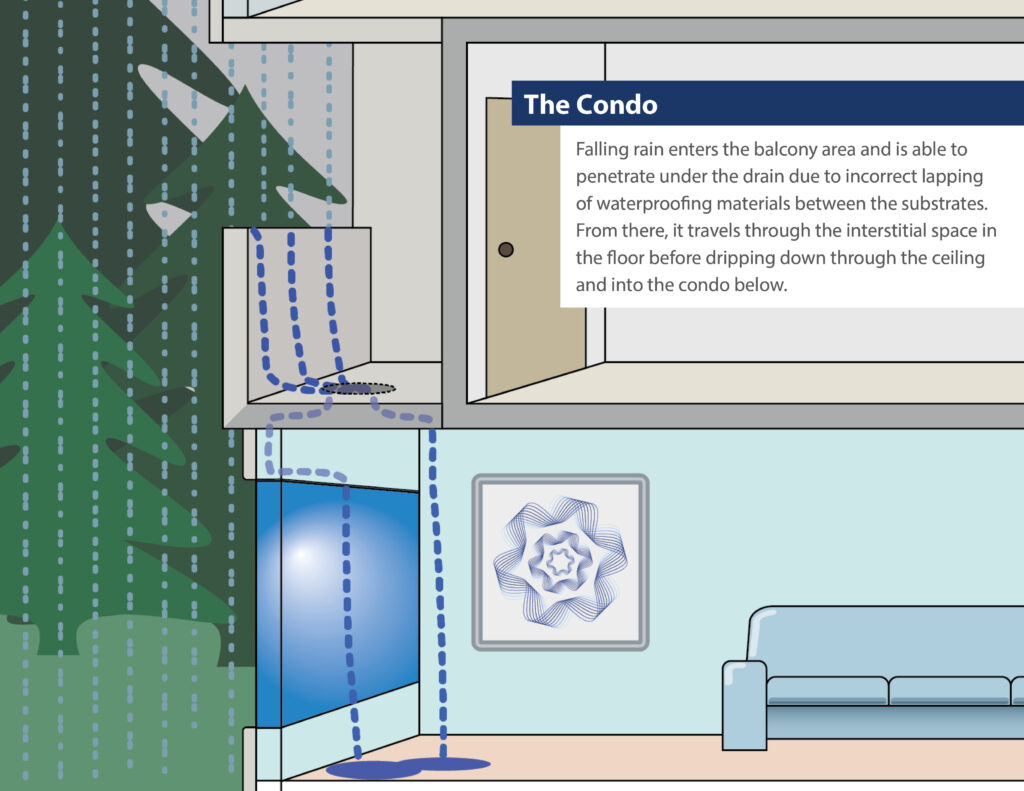
Falling rain enters the balcony area and is able to penetrate under the drain due to incorrect lapping of waterproofing materials between the substrates. From there, it travels through the interstitials space in the floor before dripping down through the ceiling and into the condo below.

Rainwater accumulates on the surface of weathered wood, then soaks into the pre-existing splits and gapped joints. Via wicking and capillary action, the water then travels through the splits and gapped joints to the interior of the home, bypassing exterior weatherproofing systems. Standing water from clogged balcony drains contributes to the deteriorated condition of the wood.
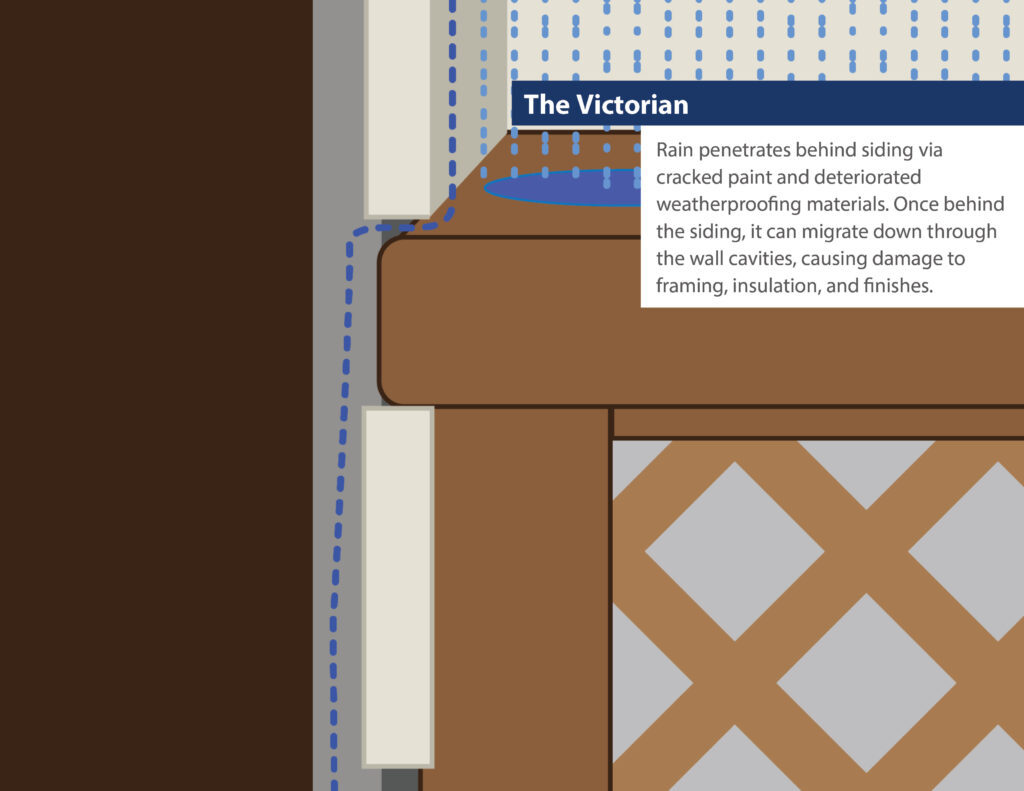
Rain penetrates behind siding via cracked paint and deteriorated weatherproofing materials. Once behind the siding, it can migrate down through the wall cavities, causing damage to framing, insulation, and finishes.
Epilogue
Each building had first noticed water intrusion during significant storm events in late 2021. Without any history of prior leaks, it was initially believed that the storms had caused the leaks. But after careful forensic assessments of each location, the physical evidence revealed the actual causes: different pre-existing issues that had manifested well before the rains fell—an initial defect in construction, a lack of routine maintenance, and dried and cracked sealants and paints, respectively. These three examples of sudden rainwater intrusion illustrate the importance of taking the time to closely examine and follow the evidence path and to not just blame the damage on the water in the storm.
Want to submit a claim? Click here:
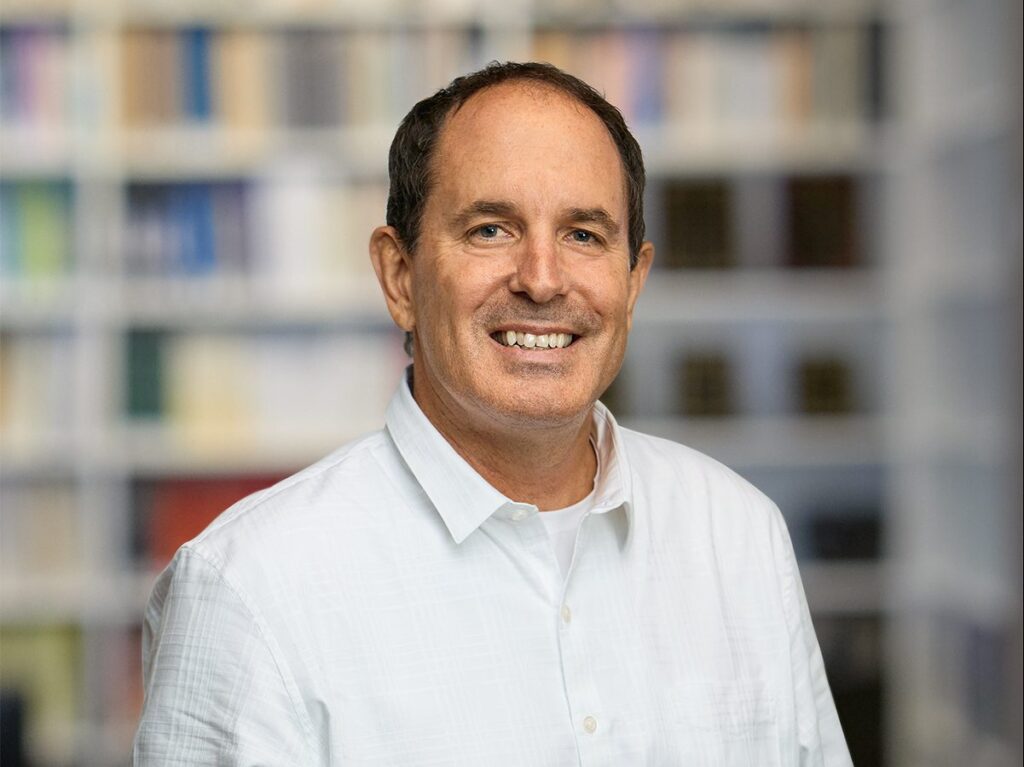
Other articles by Steve Moore:
Meet the Degenkolb Summer 2022 Interns
Degenkolb invited 13 aspiring structural engineers to join us as interns this summer! From our offices in Seattle to San Diego, these students have been learning and working alongside Degenkolbers on a variety of exciting projects these past few months. We spoke with them to hear more about their experience with the firm before they return to campus this fall.
Q&A with Degenkolb Summer 2022 Interns
____________________________________________________
Cassidy Sutton, Oakland
Where do you go to school and what year are you in?
I just got my undergraduate degree from Cal Poly San Luis Obispo in Architectural Engineering and will be returning in the fall to get my master’s degree in Architectural Engineering.
How did you find out about Degenkolb?
I have always heard about them from my peers and at Cal Poly’s Annual Structural Forum I went up and chatted with them! I have always been interested in the work at Degenkolb.
What is your most vivid memory of your time so far at Degenkolb?
My most vivid memory is probably the softball games that I’ve been to! It’s a great way to get to know my coworkers and the dinners afterward are always really fun.
If you could give any future interns advice on how to get the most out of interning with Degenkolb what would it be?
Ask questions! Everyone at Degenkolb is eager to help and wants you to succeed. You’re not supposed to know everything so ask questions and be willing to learn.
Describe your ideal day off.
My ideal day off is going on a morning hike and then going to get breakfast and coffee with friends! Then an afternoon at the park reading and relaxing.
____________________________________________________
Dominique Hayet, San Diego
Where do you go to school and what year are you in?
I just completed my undergrad at UC San Diego and will be starting at UC Berkeley for my master’s degree in the fall.
How did you find out about Degenkolb?
Outside of seeing the name at our school’s career fair, I was put in touch with the company by a close professor at UCSD who wanted to help me out in my internship search. Could not have been more grateful for how things turned out!
What is your most vivid memory of your time so far at Degenkolb?
The happy hours are hard to beat! Getting to assist in the design of a parking canopy was a very cool experience, and the Wellness Challenge team walk through downtown San Diego’s first day of Comic-Con was also a great time. And I will not forget coming into the office on my first day in-person to be greeted by a beautiful view of the Coronado Bay Bridge.
If you could give any future interns advice on how to get the most out of interning with Degenkolb what would it be?
Realize going in that you will be challenged and use that to push yourself forward and seek out help from others. There are plenty new things to learn in the office that school may not fully prepare you for, and the internship program provides an excellent opportunity for exposure and growth in this environment. You may take longer to figure things out than you expect and that is okay, but don’t try doing it all on your own. The office is full of insightful engineers and reaching out for help will always provide you with a new opportunity to learn. Take notes when you need to and get a good night’s rest to make it through the day! And although the work is serious – give yourself time for interacting and getting to know your coworkers.
Describe your ideal day off.
Depending on the season, a drive with friends either to the beach or the mountains. Soak up the sun, grab some dinner and ice cream (or Julian apple pie), and come back home to chill with music, games, and/or a movie or a nice long sleep followed by a morning workout and just relaxing at home.
____________________________________________________
Judy Guan, San Francisco
Where do you go to school and what year are you in?
I graduated from San Francisco State University with my bachelor’s degree and will be returning in the fall for the 2nd year of my master’s degree.
How did you find out about Degenkolb?
I found out about Degenkolb through a SEAONC career fair.
What is your most vivid memory of your time so far at Degenkolb?
The most vivid memory so far for me is completing my first Issue for Permit set and having my name on the drawings. It is surreal to think the things I helped design as an intern are going to be built.
If you could give any future interns advice on how to get the most out of interning with Degenkolb what would it be?
My advice for future interns is to get to know the other engineers in the office and don’t be afraid to ask questions. Everyone is willing to help so do not feel like you need to struggle to figure out the problem on your own. Interns are expected to make mistakes and need help to figure things out. Get the most out of this experience by asking questions whenever something is unclear. This internship is a great opportunity to learn and grow.
Describe your ideal day off.
My ideal day off would be waking up naturally and not to the sound of an alarm. I would take my time cooking food as well as trying out new recipes. Then I would spend my day at home watching TV shows.
____________________________________________________
Anele Siyephu, Los Angeles
Where do you go to school and what year are you in?
I completed my undergraduate degree at the University of Cape Town in South Africa. Currently, I am attending North Carolina State University and will begin my final year of my master’s degree in structural engineer this coming fall.
How did you find out about Degenkolb?
While I was researching internships, I reached out to a friend in the construction industry for networking ties. He mentioned working with Degenkolb on a few projects and was very impressed by the company. I decided to do further research into the matter and luckily came across this opportunity.
What is your most vivid memory of your time so far at Degenkolb?
Aside from the all the social events and the amazing projects I worked on, my most vivid memory must be winning a table tennis game against the highest ranked player in the LA office.
If you could give any future interns advice on how to get the most out of interning with Degenkolb what would it be?
I would advise future interns to enjoy their time, get involved, be open to learning and lastly don’t be afraid to ask questions.
Describe your ideal day off.
My ideal day would entail a morning round of golf, followed up by an afternoon of watching sports (soccer, rugby or cricket) and finally an evening “braai” with friends and family.
____________________________________________________
Jimmy Yang, San Francisco
Where do you go to school and what year are you in?
I went to undergrad at the University of British Columbia in Vancouver, Canada. After graduating, I did one year of full-time work as an EIT and decided to pursue further education at Stanford for structural engineering! I will be finishing up my last quarter at Stanford this fall and will graduate December 2022.
How did you find out about Degenkolb?
I first heard about Degenkolb during a “seismic tour” of Stanford Campus and heard Professor Deierlein mention the company’s involvement on campus. Since then, Jim has come to speak to our class in a guest lecturer series. I also had the pleasure of speaking to many current employees at school career fairs.
What is your most vivid memory of your time so far at Degenkolb?
Going on a guided tour with the entire San Francisco office to the Transamerica Pyramid is up there (pun intended) as one of the most memorable experiences I have ever had. The view at the top floor was incredible! I would recommend putting in an escalator to the top floor, even if climbing to the 60th floor was great for the Wellness Challenge.
If you could give any future interns advice on how to get the most out of interning with Degenkolb what would it be?
Be vocal about what you want to learn and do. The management at Degenkolb is very open to helping put you on projects that you want to do. Since they aren’t psychics and can’t read your mind, you have to put yourself out there and tell your project managers what kinds of projects and sectors you are interested in working in.
Describe your ideal day off.
I love going out with a small group of friends and exploring places I have never been before. I don’t mind if it’s in the city or in the back country if it’s with the right group of people!
____________________________________________________
Tyler X. Rodrigues, Oakland
Where do you go to school and what year are you in?
I just graduated with my Bachelor’s from UC Berkeley, and will be headed to Stanford this fall to start my master’s.
How did you find out about Degenkolb?
I found out about Degenkolb by word of mouth in my structural engineering classes, as well as looking for internships through websites like Handshake.
What is your most vivid memory of your time so far at Degenkolb?
I’ve really enjoyed going to the softball games and happy hours after work, as well as going on site visits and just generally learning about how things work in the industry as opposed to academia.
If you could give any future interns advice on how to get the most out of interning with Degenkolb what would it be?
Go to the social events, it really helps you get to know your co-workers better. And always communicate with your project manager; don’t be afraid to ask questions! That’s how you learn!
Describe your ideal day off.
Sleeping in, then playing video games or watching movies with friends while eating a bunch of carbs.
____________________________________________________
Chris Wolff, Oakland
Where do you go to school and what year are you in?
I attend San Francisco State University and am in the final semester of master’s program for Structural/Earthquake ENGR!
How did you find out about Degenkolb?
This internship and company were recommended to me by my academic advisor and my steel design instructor.
What is your most vivid memory of your time so far at Degenkolb?
Designing and building my first (2) 3D models based on structural/architectural plans and ASCE 7-16 chapter 13. This was a very interesting experience because I got to see how influential the different load combinations (especially the drift+gravity combos) are in determining design. It was also a good learning experience to look at a model once it is finally working from the perspective of the contractor and see if each of the chosen members make sense, or whether there is a simpler/more economical solution.
If you could give any future interns advice on how to get the most out of interning with Degenkolb what would it be?
Spend as much time around all the other engineers as possible, both in and out of the office and ask them questions. Everyone is extremely helpful and willing to share their knowledge and experience in order to give you the best intern experience possible.
Describe your ideal day off.
Playing music and eating good food with friends, going to the beach with my family, cooking a nice dinner for my partner, snowboarding with friends…how can there be only one ideal day off?
____________________________________________________
Janice Lee, Seattle
Where do you go to school and what year are you in?
I currently have one more year in my undergraduate program at Seattle University.
How did you find out about Degenkolb?
My advisor connected me with an alumnus who he had also advised during their undergrad. We met up and had a two-hour long conversation and I determined that from her description of the workplace and what Degenkolb does as a company, that I could be a great fit and vice versa.
What is your most vivid memory of your time so far at Degenkolb?
Every site visit with the forensics team have always been exciting to me, not only because I get to investigate damaged buildings, but because we often meet with the property owners. It really helps to know the face of the people who we are helping and motivates me to put my best self forward to satisfy their needs.
If you could give any future interns advice on how to get the most out of interning with Degenkolb what would it be?
My advice is to not be afraid to ask questions! It is always best to keep in mind that as an intern, I am not expected to know everything, but to be enthusiastic to make connections and learn from my coworkers.
Describe your ideal day off.
My ideal day would be going out for a meal with my loved ones and making arts and crafts together. I love painting, embroidering, and making friendship bracelets!
____________________________________________________
Garrett Barker, Los Angeles
Where do you go to school and what year are you in?
I just graduated from Cal Poly SLO with a B.S. in Architectural Engineering and will be attending UC Berkeley for my M.S. in Structural Engineering in the Fall.
How did you find out about Degenkolb?
I first learned about Degenkolb when I toured the SF office during a Cal Poly SEAOC field trip. A later Cal Poly SEAOC meeting introduced me to the LA office management.
What is your most vivid memory of your time so far at Degenkolb?
My first office happy hour, seeing everybody out of the office and getting to know a more personal side of everyone made work even more engaging.
If you could give any future interns advice on how to get the most out of interning with Degenkolb what would it be?
Face every new task as a chance to surprise your project manager with your knowledge and ability; always be thinking “how can I use my unique skillset to bring value to this task.”
Describe your ideal day off.
Going on a morning hike and then heading to a quite beach to read!
____________________________________________________
John Strickley, San Francisco
Where do you go to school and what year are you in?
I just finished my Bachelor’s in Civil Engineering at UC Berkeley and will start my master’s degree in Structural Engineering (SEMM) at Berkeley this fall.
How did you find out about Degenkolb?
One of my teammates from Cal Steel Bridge Team told me he was interning at Degenkolb last summer. I also found out just by googling “structural engineering internship San Francisco.”
What is your most vivid memory of your time so far at Degenkolb?
Playing on the Degenkolb softball team on Thursday evenings. It’s a lot of fun and something I look forward to every week.
If you could give any future interns advice on how to get the most out of interning with Degenkolb what would it be?
Don’t be scared to ask questions or tell your managers what projects you want to work on. They’re all very understanding and accommodating. Additionally, always say yes to opportunities to meet other engineers like happy hours, softball games, or just going to their desk/office to say ‘hi.’
Describe your ideal day off.
A lot of sports, such as baseball, basketball, golf, and hanging out with friends at night.
____________________________________________________
Alex Orlando, Sacramento
Where do you go to school and what year are you in?
I just graduated from UC Davis, and will be going to UCLA for my master’s in the Fall.
How did you find out about Degenkolb?
Online searches.
What is your most vivid memory of your time so far at Degenkolb?
The site visit to Westbrook Elementary School in Roseville.
If you could give any future interns advice on how to get the most out of interning with Degenkolb what would it be?
Reach out when you need help! Everyone is really nice and wants to help out.
Describe your ideal day off.
My ideal day off would be a quick day trip to Lake Tahoe.
____________________________________________________
Kevin McEntee, Oakland
Where do you go to school and what year are you in?
I go to UC Berkeley and I am currently wrapping up my undergrad and graduating this fall with my B.A. and plan on pursuing my master’s in Structural Engineering next fall.
How did you find out about Degenkolb?
I found out through Degenkolb via one of my good friends who’d been hired as an intern as well. I looked more into the company and applied and was very happy to hear back for an interview.
What is your most vivid memory of your time so far at Degenkolb?
My favorite memory here at Degenkolb was when Alex Barnes took the Oakland and Sacramento interns out to a site visit at John Muir Health Walnut Creek’s new state of the art cancer treatment center. Not only did we get to see how the plans we make get built, but it was cool to see the good we get to do here at Degenkolb for the people.
If you could give any future interns advice on how to get the most out of interning with Degenkolb what would it be?
Make sure you always ask for work well before you finish what you have. Don’t be scared to ask questions either and don’t be afraid to get up and walk into a project manager or Principal’s office for help. The people here are truly great and love to help in any way they can.
Describe your ideal day off.
My ideal day off would probably be spent in Tahoe, whether that be a day out snowboarding in the winter/spring or just spending time at the beach in the summer.
____________________________________________________
Cyrus Khoylow, Los Angeles
Where do you go to school and what year are you in?
I graduated from undergraduate at UCSD in Spring 2022 and I am going to begin my master’s degree at UCSD in Fall 2022.
How did you find out about Degenkolb?
I found out about Degenkolb through a structural engineering career fair.
What is your most vivid memory of your time so far at Degenkolb?
My most vivid memory would be my first happy hour with the office at a brewery in the Arts District of Los Angeles.
If you could give any future interns advice on how to get the most out of interning with Degenkolb what would it be?
Don’t be afraid to ask questions to anyone around the office.
Describe your ideal day off.
My ideal day off would be sleeping in and meeting up with friends in the afternoon.
____________________________________________________
Omar Mercedes, Sacramento
Where do you go to school and what year are you in?
I will be starting my master’s degree at UC Berkeley in the fall after recently graduating from UC Davis.
How did you find out about Degenkolb?
I found out about Degenkolb at the SEAONC career fair in January.
What is your most vivid memory of your time so far at Degenkolb?
My most vivid memory of my time so far at Degenkolb has been playing in the softball team while getting to know everyone outside of the office.
If you could give any future interns advice on how to get the most out of interning with Degenkolb what would it be?
Don’t be afraid to ask questions as everyone is constantly learning something new every day. Additionally, I would also encourage everyone to attend the socials and games to get to know everyone.
Describe your ideal day off.
My ideal day off would be spent all day at the beach with family and friends.
____________________________________________________
Many thanks to our 2022 summer interns!
Meet our SoCal Science & Technology Team!
Who leads the SoCal Science & Tech team?
- Jeff Roi | Principal in Los Angeles | 15 years of experience
- Chad Closs | Associate Principal in San Diego | 14 years of experience
- Sandy Hohener | Principal in Los Angeles | 13 years of experience
- Garrett Hagen | Associate Principal in Orange County | 10 years of experience
What is Science & Tech?
Our Science & Tech practice area excels at consulting and design services related to rehabilitation of existing facilities, the design of new ones, and developing corporate seismic programs nationally and internationally.
What can we do for you?
Stay tuned for more stories and ideas from the SoCal Science & Tech Team!
Orange You Glad to Meet Our New OC Office Director?
Degenkolb is excited to announce Matthew Barnard as our Orange County (OC) Office Director! 🍊
“Orange” you interested in learning more? Tune into our Q&A with Matt to hear about this exciting new chapter leading Degenkolbers in our newest office in Anaheim, CA.
2022 BNP/ENR ACE Outstanding Mentor, Laura Basualdo!
Congratulations to Degenkolb’s Laura Basualdo, S.E. for being named a 2022 BNP/ENR ACE Outstanding Mentor! 🎉
Laura was selected as one of five 2022 Outstanding Mentors because of her contribution to her students, fellow mentors, and affiliates epitomize the dedication and effectiveness of ACE’s 4,100-plus mentors. The ACE Mentor Program of America aims “to engage, excite, and enlighten high school students to pursue careers in architecture, engineering, and construction through mentoring and continued support for their advancement into the industry.”
“Laura joined ACE as soon as she started working. She was a mentor for a few months and jumped at the opportunity to be a co-team leader right away. A few years later, she co-founded a new ACE team East of Downtown LA, which she co-led until 2020. She has overseen organizing the Trades Day events for the ACE Los Angeles/Orange County affiliate for a few years now. She particularly enjoys organizing these events since the students get to learn about the trades while doing lots of different hands-on activities, and they tend to be the student’s favorite event. As a member of the ACE 2020-2021 Virtual Program Committee, she helped plan the virtual sessions during the pandemic. Laura joined the ACE LA/OC affiliate Board in 2021.” (source)
“She’s been a role model to me, and if I could describe what I want my American Dream to be like, it would be to become someone like her; a smart, creative, capable and energetic person in the architecture field helping aspiring students while also making a change in the world the way she does through her career.” – Guiseppe (Former ACE Student)
Learn more about Laura’s incredible impact as an ACE mentor for the ACE Mentor Program of LA/OC here.
Celebrating Women Making a Difference 📣
Happy Women’s History Month!
Each and every day, women across our firm are making a difference in the office, in their communities, in the field of structural engineering, and beyond. For Women’s History Month, we’re celebrating several of the many Degenkolbers who are making a positive impact through their work.
Lisette Terry (Associate, Seattle) is no exception! Hear about her involvement with iUrban Teen in a recent Q&A interview conducted for Engineers Week and learn more about the organization.
Yvonne Tsui (Associate, San Francisco) helps house people experiencing homelessness through her work with DignityMoves. On March, 8, 2022, also known as International Women’s Day, the organization held its ribbon cutting ceremony for 33 Gough Street—30 rooms of a 70-room pilot cabin project for people experiencing homelessness.
Elena Good (Design Engineer, Oakland) is one of many women Degenkolbers making a difference in and out of the office year round. Interested in learning more about SE 2050? Check out our page on the SE 2050 Commitment or visit SE2050.org.
Degenkolb Seattle – Celebrating 20 Years in the Community
Interview with Degenkolb CEO and Chairman of the Board, Stacy Bartoletti
___________________________________________
Interview with Degenkolb Principal and Seattle Group Director, Cale Ash
“Rendezvous with the Stalwarts” Interviews Degenkolb Senior Principal, Jim Malley
Tune in to the latest episode “Rendezvous with the Stalwarts” by Structural Stalwarts for an interview with Degenkolb’s very own Jim Malley (Senior Principal, San Francisco).
Please enjoy parts one and two below.
Stanford University’s Lorry I. Lokey Laboratory Studies Chemical Reactions that Provide Solutions to Science’s Biggest Questions
Since 2003, researchers at Stanford University’s Lorry I. Lokey Laboratory for Chemistry and Biological Sciences have sought to find answers to science’s biggest questions by focusing on the smallest of things: molecules, cells, and their chemical compounds. Chemical elements—much like a building’s concrete, steel, or timber—are the building blocks of everything around us. The Lorry I. Lokey Laboratory has united the brightest scientific minds studying these components, witnessing the advancement of knowledge and biochemical investigation for all.
The Lorry I. Lokey Laboratory was built to serve as the most research-intensive structure on the world-renowned Stanford University campus—and it certainly has held up to that vision. Home to research for the Chemistry and Biological Sciences departments, the $42-million, 85,000-square-foot building features state-of-the-art modular laboratories for nine principal investigators as well as 180 students and postdoctoral fellows. Their work in molecular and cell biology and advanced organic synthesis chemistry spans nearly two decades within the laboratory’s walls. Despite much of their research existing on a microscopic level, the scope of their findings is global.
One example is the Wender Group housed on Lokey’s second floor. Studying the intersection of chemistry, biology, medicine, and materials science, the group’s work emphasizes the use of synthesis “to address problems of significance in biology and medicine including eradication of HIV/AIDS, overcoming resistant cancer, and treating cognitive disorders like Alzheimer’s disease (source).” The researchers also focus on the development of new strategies to treat disease as well as new therapeutic strategies to address unsolved medical problems.
Another group is the Burns Lab which explores the “boundaries of modern organic synthesis to enable the more rapid creation of the highest molecular complexity in a predictable and controllable fashion (source).” For the non-chemist, their research seeks to answer a variety of chemical, medicinal, biological, and biophysical questions that can translate to insights, discoveries, and more for human health and the fight against illness and disease.
Chemistry surrounds us: from what we eat and wear to even think and feel. Lokey’s brilliant chemists and biologists continue to research chemical reactions that will give us solutions, benefitting science, human health, and beyond. Degenkolb Engineers was proud to have worked on the design of the laboratory along with architect, DGA.


